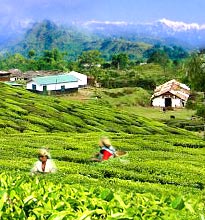 Golaghat (Gola means 'market' and Ghat means 'port of river transport') is an important district situated in the north-eastern state of Assam. With a total population of about 945,781 (as recorded in 2001), the place is one of the oldest existing former subdivision formed in the pre-independence India (in the year 1848). One hundred and thirty nine years later, in October 1987, the place was finally coined as a fully-fledged district containing three main subdivisions - Golaghat, Bokakhat and Dhansiri. Golaghat is surrounded by the mighty Brahmaputra River in the north, Nagaland in the south, Jorhat district in the east and Karbi Anglong and Nagaon district towards the south.
Golaghat (Gola means 'market' and Ghat means 'port of river transport') is an important district situated in the north-eastern state of Assam. With a total population of about 945,781 (as recorded in 2001), the place is one of the oldest existing former subdivision formed in the pre-independence India (in the year 1848). One hundred and thirty nine years later, in October 1987, the place was finally coined as a fully-fledged district containing three main subdivisions - Golaghat, Bokakhat and Dhansiri. Golaghat is surrounded by the mighty Brahmaputra River in the north, Nagaland in the south, Jorhat district in the east and Karbi Anglong and Nagaon district towards the south.Another major river passing through this region is Dhansiri, which has its origins in the state of Nagaland. The four main tributaries of this river are Doyang, Nambor, Doigrung and Kalioni. As evident from the name, the origin of the place can be traced back to the markets, which were established by the Marwaris (business class people from Rajasthan). The prime cultivations of the place include tea, sugarcane, rice, pineapple, oranges, and mustard. There are around 63 large tea gardens in Golaghat, producing about 20,000 tones of tea every year, with the number still increasing.
The tea gardens of Golaghat have greatly contributed to the economy of the place. Besides this, the Numaligarh Refinery Limited set up during the earlier part of the 20th century, is one of the most important industries of this region, and has recently obtained global standards for its quality and management. Visiting Golaghat is really a unique experience for the travelers as well as the tourists. Some of the major attractions of the place include Garampani, Negheriting Shiv Mandir, Deopahar Ruins, Uncle Robinís Children Museum and the Kaziranga National Park.
Deopahar
Deopahar is a very famous historical natural spot located within the district of Golaghat, Assam. The place, with its ancient monuments and ruins, lies close to the NRL (Numaligarh Refinery Limited) complex within Golaghat District. Mythology often relates this place with the Kingdom of Jarasanda, in ancient Assam.
Golaghat Excursions
Golaghat, bounded by Brahmaputra River in the north and the state of Nagaland in the south, is a major administrative district of Assam. With a total population of about 945,781, the majority of which comprises of cultivators, the region contributes a lot to the production and economy of the state.
How to Reach Golaghat
While traveling to a place, it is important to know about the modes of transportation prevalent in and around the area. This way, the journey becomes easy and more convenient. The district of Golaghat has a good network of roadways and railways, which makes reaching the place an easy affair. Since traveling to this place is completely hassle-free, people come from far and wide to enjoy its scenes and sights.
Uncle Robinís Children Museum
A medical doctor from Edinburgh and Liverpool Universities, a Padmashree Award winner, and a naturalist of international repute, Dr Robin Banerjee is the one who established the famous children museum in the district of Golaghat. Born in the Murshidabad district of West Bengal, Bannerjee joined the British Army in 1937, after completing his medical degree from UK.
Golaghat Weather
The district of Golaghat, occupying a total area of 3502 sq km, lies at an elevation of about 100 m above the sea level. Like the rest of the state, the district has a sub-tropical humid type of climate, with the relative humidity varying from 93% to 95% during the morning hours and from 53% to 75 % during the afternoons.











